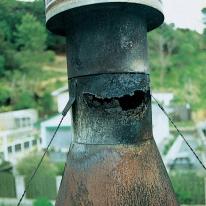Corrosion of cowl and/or flue pipe
Listed under: metal, chimneys and flues and fireplaces, durability, corrosion, rust
Cause
Corrosive particulates from the combustion process
Repair
-
call an experienced installer to check the condition of the cowl and flue and replace if necessary. You can find a list of installers on the website of the New Zealand Home Heating Association
-
a new flue installation must comply with the standard AS/NZS 2918:2018 Domestic solid fuel burning appliances – Installation regarding flue clearances etc. New woodburner flue systems are typically stainless steel a minimum 0.52 mm thick.
-
if you have just moved into a property it is considered prudent to have any existing woodburner firebox, flue and cowl checked by an experienced installer. If you decide to replace an old woodburner, check which models can be used in your location. See this page for more details
-
avoid burning salt-laden wood (such as driftwood), treated timber (particularly wood treated with a copper-based preservative such as CCA, copper azole or ammoniacal copper quaternary) or painted timber. Burn only dry, clean firewood
-
most woodburners are designed to run with a hot, efficient fire. Continually operating a low-level smouldering fire can contribute to flue problems
-
note that if a solid fuel burner is operated in a dangerous condition, house insurance may not cover any resulting damage
Cause
Burning treated timber or driftwood (both contain corrosive salts)
Repair
- follow the steps in the first repair
Cause
Material is at the end of its serviceable life
Repair
- follow the steps in the first repair
Cause
Wrong specification for the environment
Repair
- follow the steps in the first repair, specifying 316 stainless steel for a replacement flue system for coastal and other severe environments rather than 304





